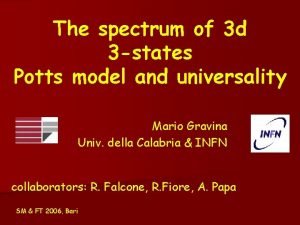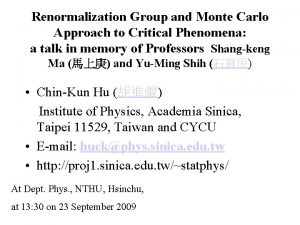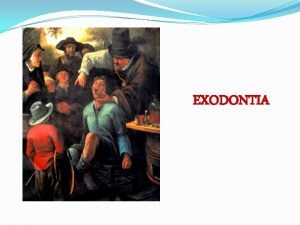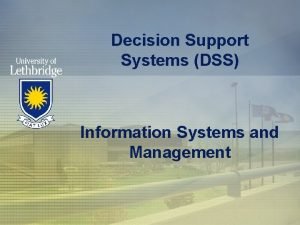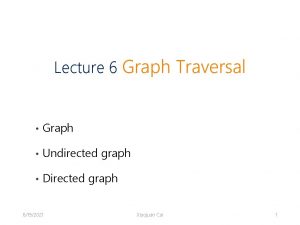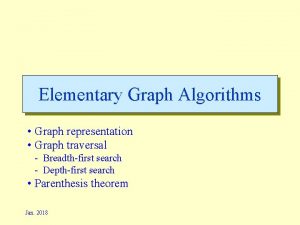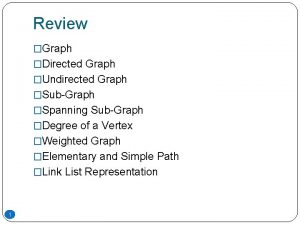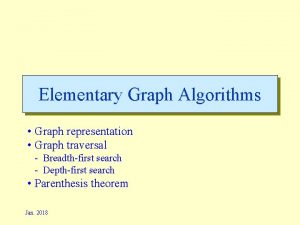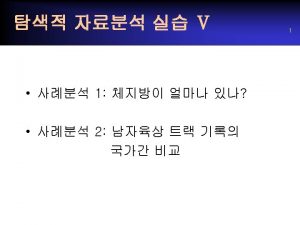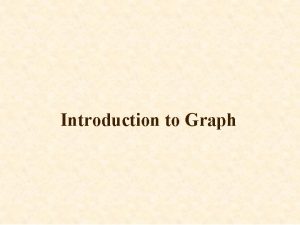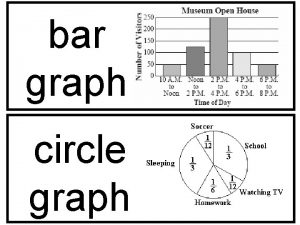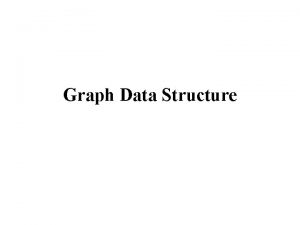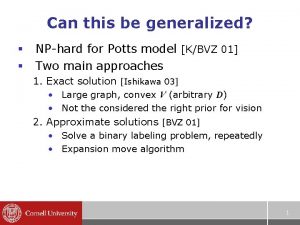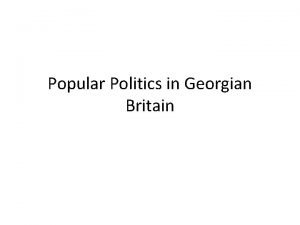The Increasingly Popular Potts Model or A Graph





























- Slides: 29

The Increasingly Popular Potts Model or A Graph Theorist Does Physics (!) Jo Ellis-Monaghan e-mail: jellis-monaghan@smcvt. edu website: http: //academics. smcvt. edu/jellis-monaghan 10/27/05 1

Getting by with a little (a lot of!) help from my friends…. • • • Patrick Redmond (SMC 2010) Eva Ellis-Monaghan (Villanova 2010) Laura Beaudin (SMC 2006) Patti Bodkin (SMC 2004) Whitney Sherman (SMC 2004) This work is supported by the Vermont Genetics Network through NIH Grant Number 1 P 20 RR 16462 from the INBRE program of the National Center for Research Resources. 10/27/05 • • Mary Cox (UVM grad) Robert Schrock (SUNY Stonybrook) Greta Pangborn (SMC) Alan Sokal (NYU) Isaac Newton Institute for Mathematical Sciences Cambridge University, UK 2

Applications of the Potts Model ● Liquid-gas transitions ● Foam behaviors ● Magnetism ● Biological Membranes ● Social Behavior ● Separation in binary alloys ● Spin glasses ● Neural Networks ● Flocking birds ● Beating heart cells 10/27/05 These are all complex systems with nearest neighbor interactions. These microscale interactions determine the macroscale behaviors of the system, in particular phase transitions. 3

Ernst Ising 1900 -1998 Ising, E. Beitrag zur Theorie des Ferromagnetismus. Zeitschrift fr Physik 31 (1925), 253 -258. 72, 500 Articles on ‘Potts Model’ found by Google Scholar http: //www. physik. tu-dresden. de/itp/members/kobe/isingconf. html 10/27/05 4

The Ising Model Consider a sheet of metal: It has the property that at low temperatures it is magnetized, but as the temperature increases, the magnetism “melts away”*. We would like to model this behavior. We make some simplifying assumptions to do so. – The individual atoms have a “spin”, i. e. , they act like little bar magnets, and can either point up (a spin of +1), or down (a spin of – 1). – Neighboring atoms with the same spins have an interaction energy, which we will assume is constant. – The atoms are arranged in a regular lattice. 10/27/05 *Mathematicians should NOT attempt this at home… 5

One possible state of the lattice A choice of ‘spin’ at each lattice point. Ising Model has a choice of two possible spins at each point 10/27/05 6

The Kronecker delta function and the Hamiltonian of a state Kronecker delta-function is defined as: The Hamiltonian of a system is the sum of the energies on edges with endpoints having the same spins. 10/27/05 7

The energy (Hamiltonian) of the state Endpoints have the same spins, so δ is 1. Endpoints have different spins, so δ is 0. of this system is A state w with the value of δ marked on each edge. 10/27/05 8

The Potts Model Now let there be q possible states…. Orthogonal vectors, with δ replaced by dot product Colorings of the points with q colors Healthy 10/27/05 Sick Necrotic States pertinent to the application 9

More states--Same Hamiltonian § The Hamiltonian still measures the overall energy of the a state of a system. The Hamiltonian of a state of a 4 X 4 lattice with 3 choices of spins (colors) for each element. 1 0 0 1 0 1 1 0 0 1 (note—qn possible states) 10/27/05 3 10

Probability of a state The probability of a particular state S occurring depends on the temperature, T (or other measure of activity level in the application) --Boltzmann probability distribution-- The numerator is easy. The denominator, called the Potts Model Partition Function, is the interesting (hard) piece. 10/27/05 4 11

Example Minimum Energy States 10/27/05 4 The Potts model partition function of a square lattice with two possible spins 12

Probability of a state occurring depends on the temperature P(all red, T=0. 01) =. 50 or 50% P(all red, T=2. 29) = 0. 19 or 19% P(all red, T = 100, 000) = 0. 0625 = 1/16 Setting J = k for convenience, so 10/27/05 13

Effect of Temperature • Consider two different states A and B, with H(A) < H(B). The relative probability of the two states is: • At high temperatures (i. e. , for k. T much larger than the energy difference |D|), the system becomes equally likely to be in either of the states A or B that is, randomness and entropy "win". On the other hand, if the energy difference is much larger than k. T (very likely at low temperatures), the system is far more likely to be in the lower energy state. 10/27/05 14

Ising Model at different temperatures Cold Temperature Hot Temperature Here H is and energy is Critical Temperature 10/27/05 Images from http: //bartok. ucsc. edu/peter/java/ising/keep/ising. html http: //spot. colorado. edu/~beale/Potts. Model/MDFrame. Applet. html 15

Monte Carlo Simulations ? http: //www. pha. jhu. edu/~javalab/potts. html 10/27/05 16

Monte Carlo Simulations Generate a random number r between 0 and 1. B (stay old) B (old) 10/27/05 A (change to new) 17

Capture effect of temperature Given r between 0 and 1, and that , with B the current state and A the one we are considering changing to, we have: High Temp H(B) < H(A) exp(‘-’/k. T) ~1 B is a lower energy state > r, so change states. than A H(B) > H(A) B is a higher energy state than A 10/27/05 Low Temp exp(‘-’/k. T) ~ 0 < r, so stay in low energy state. exp(‘+’/k. T) ~1 > r, so change states. > r, so change to lower energy state. 18

Foams § “Foams are of practical importance in applications as diverse as brewing, lubrication, oil recovery, and fire fighting”. § The energy function is modified by the area of a bubble. Results: Larger bubbles flow faster. There is a critical velocity at which the foam starts to flow uncontrollably 10/27/05 9 19

A personal favorite Y. Jiang, J. Glazier, Foam Drainage: Extended Large-Q Potts Model Simulation We study foam drainage using the large-Q Potts model. . . profiles of draining beer foams, whipped cream, and egg white. . . http: //www. lactamme. polytechnique. fr/Mosaic/images/ISIN. 41. 16. D/display. html 10/27/05 Olympic Foam: http: //mathdl. maa. org/math. DL? pa=math. Ne ws&sa=view&news. Id=392 20

Life Sciences Applications § This model was developed to see if tumor growth is influenced by the amount and location of a nutrient. § Energy function is modified by the volume of a cell and the amount of nutrients. Results: 10/27/05 7 Tumors grow exponentially in the beginning. The tumor migrated toward the nutrient. 21

Sociological Application § The Potts model may be used to “examine some of the individual incentives, and perceptions of difference, that can lead collectively to segregation …”. § (T. C. Schelling won the 2005 Nobel prize in economics for this work) Variables: Preferences of individuals Size of the neighborhoods Number of individuals 10/27/05 8 22

What’s a nice graph theorist doing with all this physics? • If two vertices have different spins, they don’t interact, so there might as well not be an edge between them (so delete it). • If two adjacent vertices have the same spin, they interact with their neighbors in exactly the same way, so they might as well be the same vertex (so contract the edge)*. Delete e e G *with a weight for the interaction energy 10/27/05 G-e Contract e G/e 23

Bridges and Loops bridges Not a bridge A bridge is an edge whose deletion separates the graph 10/27/05 A loop is an edge with both ends incident to the same vertex 24

Tutte Polynomial (The most famous of all graph polynomials) Let e be an edge of G that is neither a bridge nor a loop. Then, And if G consists of i bridges and j loops, then 10/27/05 25

Example The Tutte polynomial of a cycle on 4 vertices… = + + 10/27/05 13 + = + + + = = 26

The q-state Potts Model Partition Function is an evaluation of the Tutte Polynomial! If we let , and have q states, then: The Potts Model Partition Function is a polynomial in q!!! Fortuin and Kasteleyn, 1972 10/27/05 27

Example The Tutte polynomial of a 4 -cycle: Compute Potts model partition function from the Universality Theorem result: Let q = 2 and 10/27/05 13 28

Thank you for attending! • Questions? 10/27/05 29
 Straight coupland elevator
Straight coupland elevator Adrian potts
Adrian potts Lynn potts md
Lynn potts md Maureen potts
Maureen potts Potts
Potts Colin potts gatech
Colin potts gatech Lever principle in extraction
Lever principle in extraction Why are mobile systems increasingly important?
Why are mobile systems increasingly important? Local area decision network
Local area decision network Hình ảnh bộ gõ cơ thể búng tay
Hình ảnh bộ gõ cơ thể búng tay Frameset trong html5
Frameset trong html5 Bổ thể
Bổ thể Tỉ lệ cơ thể trẻ em
Tỉ lệ cơ thể trẻ em Gấu đi như thế nào
Gấu đi như thế nào Glasgow thang điểm
Glasgow thang điểm Alleluia hat len nguoi oi
Alleluia hat len nguoi oi Các môn thể thao bắt đầu bằng tiếng chạy
Các môn thể thao bắt đầu bằng tiếng chạy Thế nào là hệ số cao nhất
Thế nào là hệ số cao nhất Các châu lục và đại dương trên thế giới
Các châu lục và đại dương trên thế giới Cong thức tính động năng
Cong thức tính động năng Trời xanh đây là của chúng ta thể thơ
Trời xanh đây là của chúng ta thể thơ Mật thư anh em như thể tay chân
Mật thư anh em như thể tay chân Phép trừ bù
Phép trừ bù độ dài liên kết
độ dài liên kết Các châu lục và đại dương trên thế giới
Các châu lục và đại dương trên thế giới Thơ thất ngôn tứ tuyệt đường luật
Thơ thất ngôn tứ tuyệt đường luật Quá trình desamine hóa có thể tạo ra
Quá trình desamine hóa có thể tạo ra Một số thể thơ truyền thống
Một số thể thơ truyền thống Cái miệng bé xinh thế chỉ nói điều hay thôi
Cái miệng bé xinh thế chỉ nói điều hay thôi Vẽ hình chiếu vuông góc của vật thể sau
Vẽ hình chiếu vuông góc của vật thể sau


